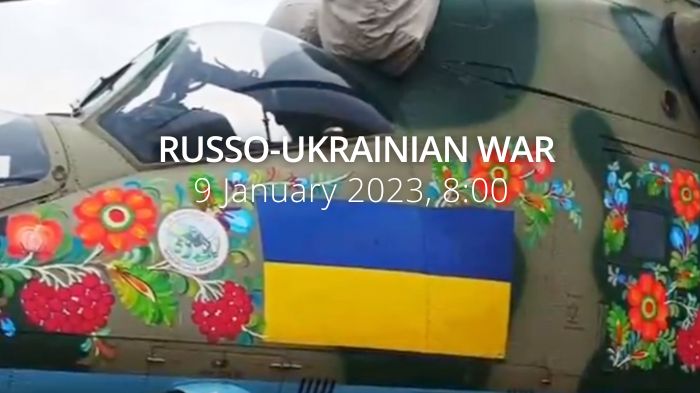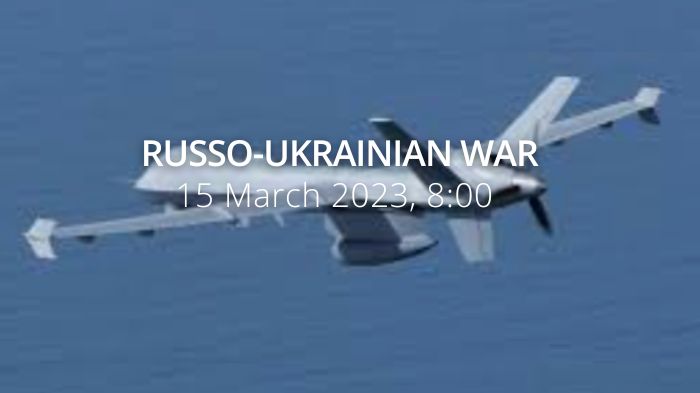The Kremlin ordered the detention and suspension of several senior military officers. Russia actively redeploys military personnel, ammunition, and equipment across Crimean Bridge. EU helps UN, Türkiye in bid to extend Black Sea grain deal.
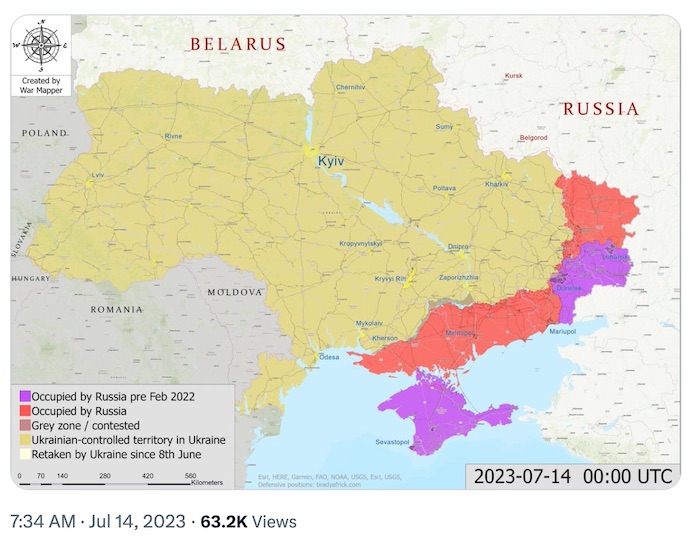
Daily overview — Summary report, July 14
The General Staff’s operational update regarding the Russian invasion as of 18.00 pm, July 14, 2023 is in the dropdown menu below:
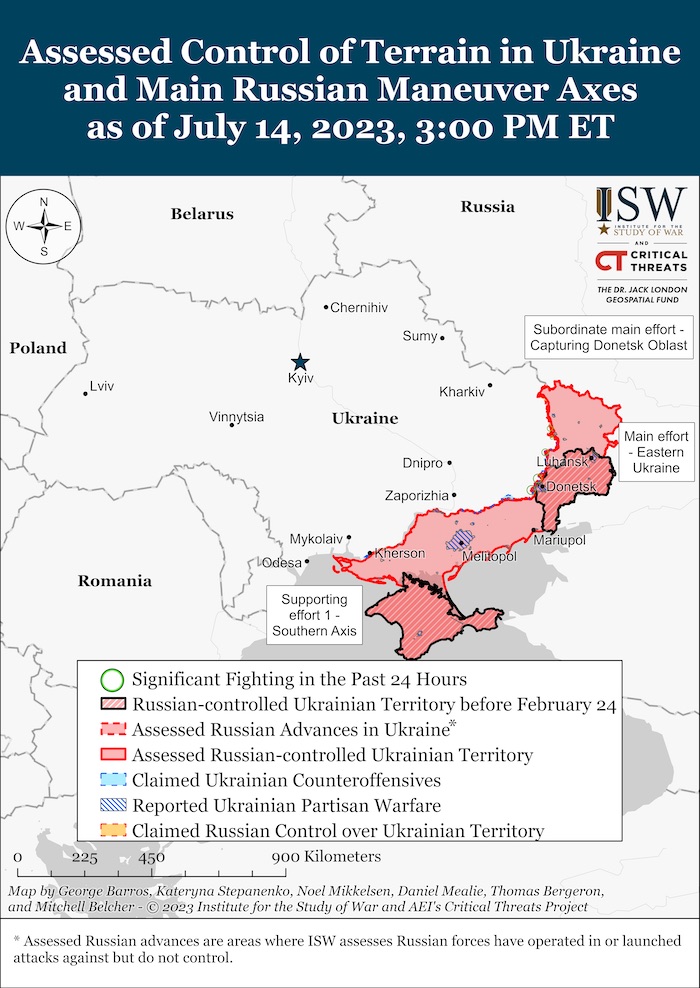
- Volyn and Polissya axes: no significant changes. [There are no signs of the formation of offensive groupings. Armed Forces of Belarus continue to perform tasks on the Ukrainian border.]

- Sivershchyna and Slobozhanshchyna axes: On July 13, the adversary launched an airstrike in the vicinity of Veterynarne (Kharkiv oblast). The invaders fired mortars and artillery at more than 15 settlements, including Kamin’ (Chernihiv oblast), Pokrovka, Ryasne, Velyka Pysarivka (Sumy oblast), Muravs’ke, Oliinykove, Riznykove, and Bolohivka (Kharkiv oblast).
- Kupiansk axis: the Ukrainian troops are standing their ground. The adversary launched airstrikes in the vicinities of Kyslivka and Kotlyarivka. Stroivka, Krasne Pershe, Novomlyns’k, Dvorichna, Zapadne, and Kup’yans’k (Kharkiv oblast) came under artillery and mortar fire.
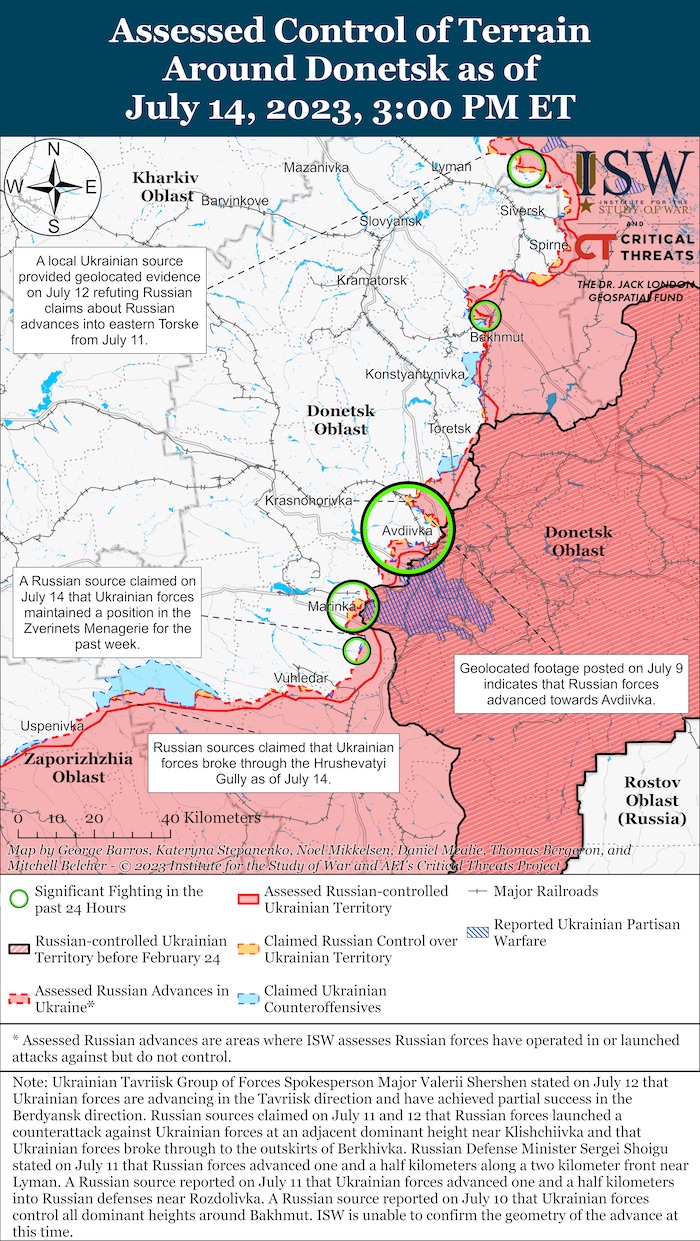
- Lyman axis: On July 14, the adversary conducted unsuccessful offensives east of Nevske (Luhansk Oblast) and east of Terny (Donetsk Oblast). The invaders launched airstrikes in the vicinities of Nevske and Bilohorivka (Luhansk Oblast) and Spirne (Donetsk Oblast). More than 10 settlements, including Nevske, Bilohorivka (Luhansk oblast), Tors’ke, Verkhn’okam’yans’ke, Spirne, and Rozdolivka (Donetsk oblast), were shelled with artillery.
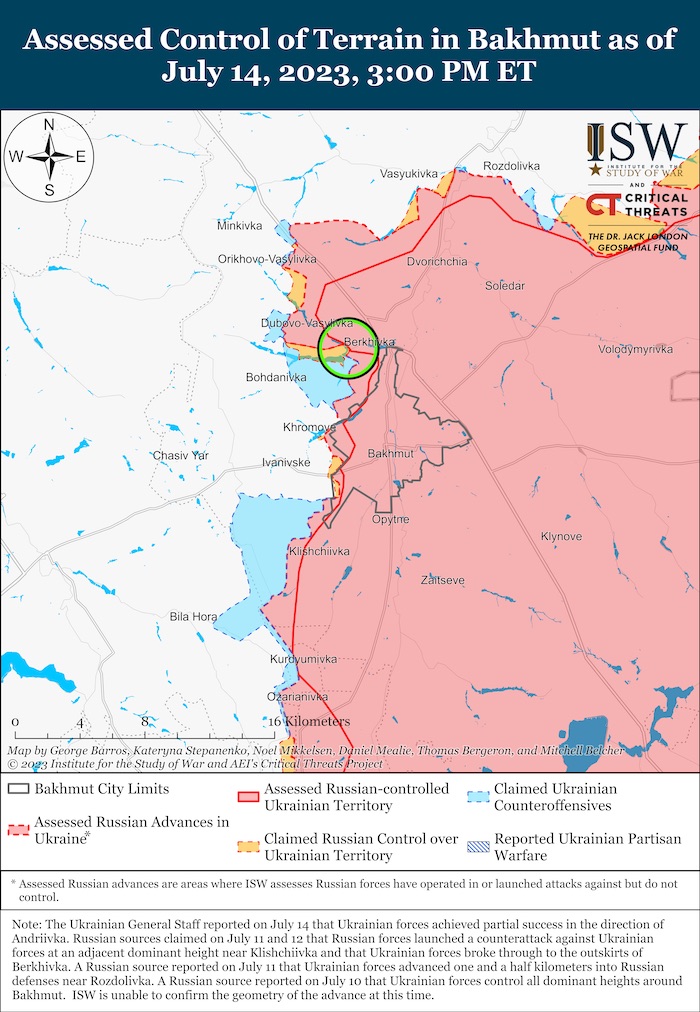
- Bakhmut axis: under heavy fire from enemy aircraft and artillery, the Ukrainian defenders successfully repelled all enemy attacks in the vicinity of Berkhivka. More than 15 settlements, including Vasyukivka, Chasiv Yar, Oleksandro-Shul’tyne, Dyliivka, and Pivnichne (Donetsk oblast), suffered from enemy artillery shelling.
- Avdiivka axis: under heavy fire from enemy artillery, the Ukrainian defenders successfully repelled Russian troops’ attacks in the vicinity of Pervomaiske (Donetsk oblast). The enemy launched an airstrike near Avdiivka. At the same time, the invaders fired artillery at more than 10 settlements, including Berdychi, Stepove, and Avdiivka (Donetsk oblast).
- Marinka axis: the Ukrainian Defence Forces continue to hold back the Russian offensive in the vicinity of Mar’inka. The adversary shelled more than 10 settlements, including Krasnohorivka, Marinka, and Heorhiivka (Donetsk oblast).
- Shakhtarske axis: the adversary conducted unsuccessful offensive operations in the vicinity of Novomykhailivka. The invaders launched an airstrike near Makarivka and shelled the settlements of Paraskoviivka, Novomykhailivka, Novoukrainka, Storozheve, Blahodatne, and Makarivka (Donetsk oblast).
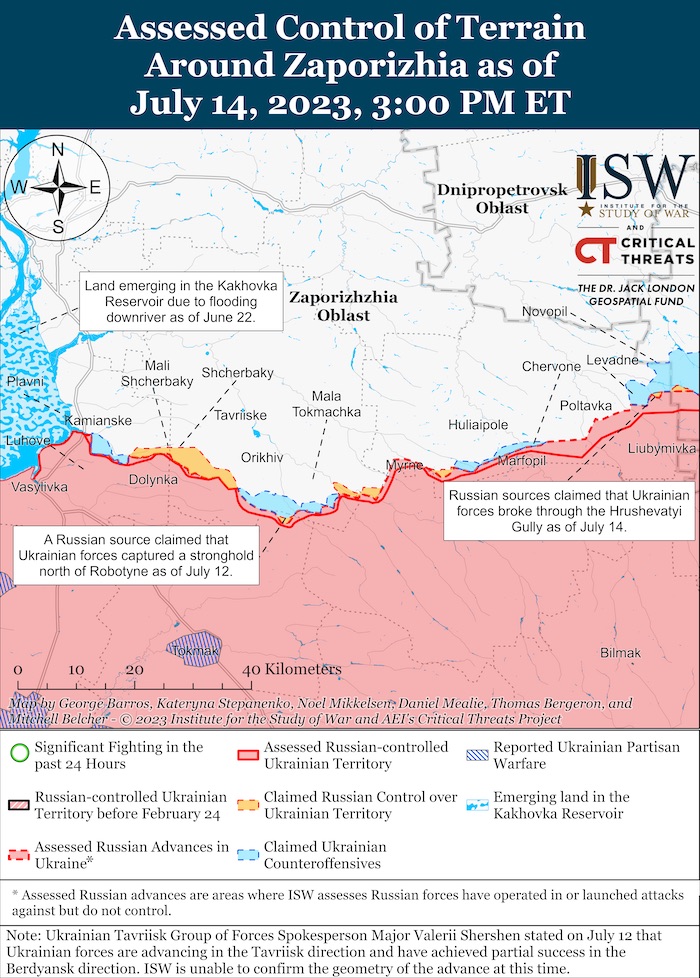
- Zaporizhzhia and Kherson axes: the adversary focuses its main efforts on preventing a further advance of Ukrainian troops. The invaders launched airstrikes in the vicinities of settlements of Pryyutne, Rivnopil’, Mala Tokmachka, Orikhiv, Malokaterinivka (Zaporizhzhia oblast), and Kozats’ke (Kherson oblast). The invaders shelled more than 20 settlements, including Novodarivka, Malynivka, Hulyaipole, Zaliznychne, Bilohir’ya, Orikhiv (Zaporizhzhia oblast), Zolota Balka, Mykhailivka, Antonivka, Chornobaivka, Kizomys (Kherson oblast), and the city of Kherson. At the same time, the Ukrainian Defense Forces continue to conduct the offensive operation on Melitopol’ and Berdyans’k axes, consolidating their positions, firing artillery for effect on the identified enemy targets, and conducting counter-battery fire.

Military Updates

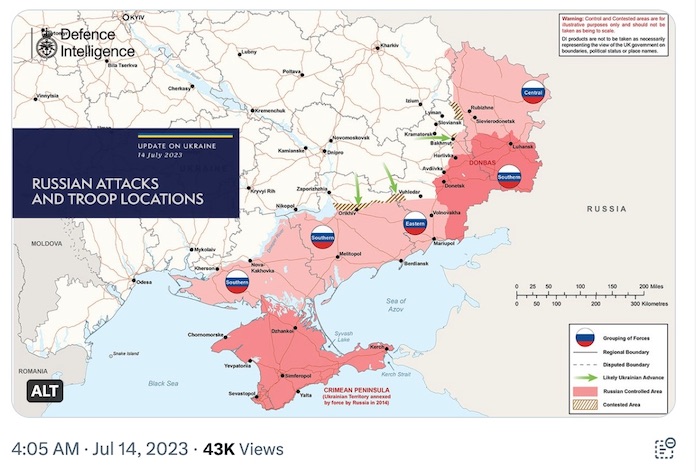
- On 12 July 2023, Russian state media reported that nuclear-powered submarines of Russia's Northern Fleet will not be taking part in the main Navy Day fleet review in St Petersburg on 30 July 2023.
- Since the current Navy Day format was established in 2017, this would be the first year that no nuclear-powered submarines have been involved. The change is likely primarily due to allow for maintenance and to retain availability for operations and training.
- There is also a realistic possibility that internal security concerns since Wagner Group’s attempted mutiny have contributed to the decision.
- In June 2023, there have been several reports of Russian forces using antiquated armoured vehicles packed with several tonnes of explosives as vehicle-borne improvised explosive devices (VBIEDs). The crew likely bail out of the vehicle after setting it on its course.
- Most Russian VBIED cases have been reported around Marinka, near Donetsk city, and started days after Chechen units reinforced the area: there is a realistic possibility that Chechen forces are pioneering the tactic.
- There is a heritage of Chechen fighters being skilled in IED use, dating back to the Chechen Wars from the 1990s. Chechens fighting for Ukraine were also reported to have made similar VBIEDs in January 2023.
- Most of Russia’s VBIEDs have almost certainly detonated before they reached their target through a combination of anti-tank mines and direct fire, bringing into question the viability of the capability. However, these VBIEDs cause extremely large explosions, which are still likely to have a psychological effect on defending forces.
Losses of the Russian army
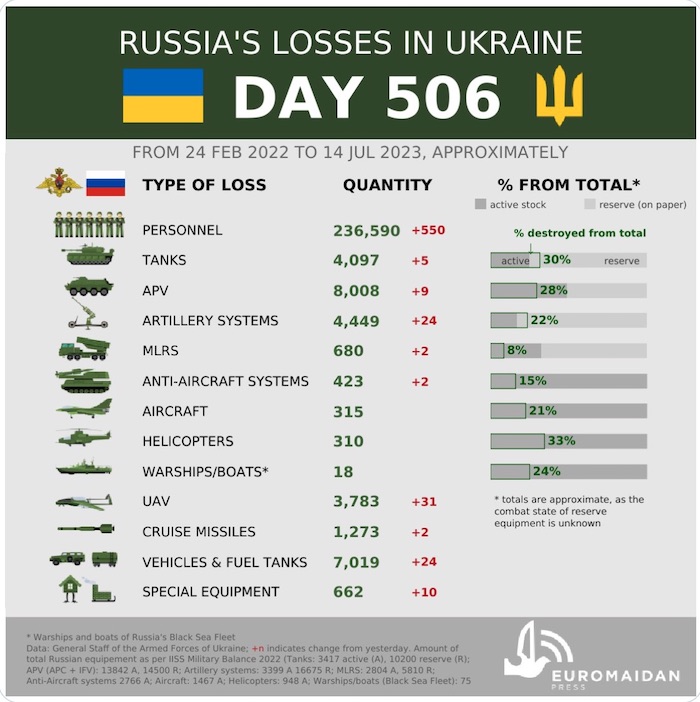
- Personnel – about 236590 (+550)
- Tanks – 4097 (+5)
- Armoured combat vehicles – 8008 (+9)
- Artillery systems – 4449 (+24)
- Multiple rocket launchers –MLRS - 680 (+2)
- Air defence means – 423 (+2)
- Aircraft - 315 (+0)
- Helicopters - 310 (+0)
- Automotive technology and fuel tanks – 7019 (+24)
- Vessels/boats - 18 (+0)
- UAV operational and tactical level – 3783 (+31)
- Special equipment – 662 (+10)
- Mobile SRBM system – 4 (+0)
- Cruise missiles – 1273 (+2)
Humanitarian
Close to half of Ukrainian refugees in Germany hope to stay, Reuters reports. “Of the more than 1 million Ukrainian refugees who came to Germany to escape the war, 44% would like to stay in the country, according to a survey published on Wednesday. This was higher than the 39% of Ukrainian refugees who said they were planning to stay in a previous survey published in late summer 2022. Of those polled in the new survey, 18% had found a job, up only slightly from 17% in late summer 2022.” EU helping UN, Türkiye in bid to extend Black Sea grain deal, Reuters reports. “The European Commission is helping the United Nations and Türkiye try to extend a deal allowing the Black Sea export of Ukraine grain - that could expire on Monday - and is open to "explore all solutions," a European Union spokesperson said on Thursday. The EU is considering connecting a subsidiary of the Russian Agricultural Bank (Rosselkhozbank) to the international payment network SWIFT to allow for grain and fertilizer transactions, sources familiar with discussions told Reuters on Wednesday. UN Secretary-General Antonio Guterres proposed in a letter to Russian President Vladimir Putin on Tuesday that Moscow allow the Black Sea grain deal to continue for several months to give the EU time to connect a Rosselkhozbank subsidiary to SWIFT, two of those sources familiar with discussions told Reuters. During a visit to Brussels on Thursday, Guterres told reporters that he had not yet received a response from Russia. He said his letter to Putin contained "concrete proposals that I hope can allow us to find a positive way forward."Environmental
About 500 Russian military personnel and Rosatom employees are at ZNPP, Ukrinform reports. "About 500 Russian soldiers and Rosatom employees are at the plant. We don't know what kind of weapons they use to mine the plant, Head of the Zaporizhzhia Regional Military Administration Yuriy Malashko told a briefing. Malashko stated that the invaders use the plant’s territory to shell the populated settlements of Zaporizhzhia and Dnipropetrovsk regions and also store weapons and ammunition there. The governor added that it was decided to measure the radiation level in Zaporizhzhia region every two hours to control the radiation background. As reported, according to Energoatom data, the water level in the Zaporizhzhia Nuclear Power Plant's cooling pond remains stable as of July 13. The ZNPP power units have not been operating since September 2022, and since then there has been no active evaporation of water. On July 4, the Armed Forces of Ukraine officially warned about the possible preparation of provocations at the ZNPP by the Russian invaders. The IAEA announced on July 12 that the organization's experts did not find any mines or explosives during the inspection of the ZNPP. However, it admitted that it was still waiting for permission from the Russians to access the roofs of the third and fourth reactors, were, according to available information, there may be explosives.” In case of terrorist attack on Zaporizhzhia NPP, people will have to be evacuated within 50 kilometres radius, Ukrainska Pravda reports, citing Ihor Kuzin, Chief State Sanitary Doctor and Deputy Minister of Health, in an interview with Ukrinform. “The chief sanitary doctor of Ukraine said that in the event of a terrorist attack perpetrated by Russians at the Zaporizhzhia Nuclear Power Plant (ZNPP), people will have to be evacuated from the zone with a radius of 50 kilometres around the station. […] We expect that the level of pollution in this area may be such that evacuation will most likely be necessary if this release and the accident itself are at the maximum possible level. But I want to emphasise that more detailed forecasts can be provided when we have detailed information about the actual emergency that has already happened. Currently, a certain part of ZNPP power units has been on shutdown and is not in operation. According to Kuzin, when a nuclear plant is not in operation, there is no radioactive iodine, the release of which can occur during a potential accident. […] Kuzin recalled that in case of an accident, it is recommended to prepare at least a week's supply of water, which should be in a sealed package: To form reserves of water, food, clean things, especially if they live in a potential accident zone.”Legal
AP learns about Russians' abuse of Ukrainians in occupation: torture, slave labour, deportation, Ukrainska Pravda reports, citing Associated Press (AP). “Thousands of Ukrainian civilians are being detained across Russia and the Ukrainian territories it occupies, in centres ranging from brand-new wings in Russian prisons to clammy basements. Most have no status under Russian law. AP spoke to dozens of people, including former detainees, prisoners of war, and their relatives. Their stories, as well as satellite imagery, social media, government documents and copies of letters provided by the Red Cross, confirm a widespread Russian system of detention and ill-treatment of civilians in direct violation of the Geneva Conventions. In particular, in one case, Ukrainian civilians were reportedly woken up long before dawn in the bitter cold, lined up for a single toilet and loaded into a cattle trailer at gunpoint. They spent the next 12 hours or more digging trenches for Russian soldiers on the front line. Many were forced by the occupiers to wear large Russian military uniforms, which could make them a target. By the end of the day, their hands were curled into icy claws. In the occupied part of Zaporizhzhia Oblast, Ukrainian civilians dug mass graves in the frozen ground for their fellow prisoners who did not survive. A man who refused to dig was shot dead on the spot. According to the AP, Russia plans to detain possibly thousands more Ukrainians. A document from the Russian government dating January obtained by the agency outlines plans to create 25 new penal colonies and 6 other detention centres in occupied Ukraine by 2026. In addition, in May, Russian President Vladimir Putin signed a decree that allows Russia to send people from territories under martial law, which includes all of occupied Ukraine, to places without it, such as Russia. This facilitates the deportation of Ukrainians who resist the Russian occupation to indefinite detention deep into Russia, which has happened in many cases. Many civilians are detained by the Russians for allegedly minor offences, such as speaking Ukrainian or simply being in the occupied oblast, and often held without charge. Others are accused of being terrorists, combatants or people who resist the special military operation. Hundreds of people are used by the Russian military for slave labour, digging trenches and other fortifications, and mass graves. Torture is also a routine practice, including repeated electric shocks, beatings that crack skulls and break ribs, and simulated suffocation. Many former prisoners told AP they had witnessed deaths. A UN report published in late June documented 77 summary executions of civilians, as well as the death of one person due to torture. Russia does not acknowledge holding civilians at all, let alone its reasons for doing so. But the prisoners serve as future bargaining chips in exchanges for Russian soldiers, and the UN has said there is evidence of civilians being used as human shields near the front lines, AP writes.” Electric shock to chest, waterboarding, beatings: how Russians abused women in occupied Kherson, Ukrainska Pravda reports, citing Onysiia Syniuk, legal analyst of ZMINA, presentation of the report on Ukrainian women held by Russia at a press conference in Ukrinform. “We managed to record cases of torture against five women. [The Russians used] beatings, the use of electric current, the use of water. Water was either poured into the mouth, or a cotton cloth was pulled over the head, the water poured on it, and when it dried, it contracted and did not let air pass. Electric shock was applied to the bare chest." According to Syniuk, human rights defenders of the ZMINA Human Rights Centre collected testimonies of victims and witnesses. In particular, about 30 women were identified, who at different times were kept on the premises of the temporary detention centre No 1 of the General Directorate of the National Police in Kherson Oblast. According to human rights activists, women were constantly humiliated. They were forcibly stripped during detention, them and their children threatened with rape. Psychological violence was used. In particular, some torture was carried out in cells in the presence of other women to intimidate detainees. The tortures themselves were carried out day and night; screams were heard in all rooms of the isolator. One of the victims was forced to listen to the cries of her husband, who was held in the cell nearby. For more effective psychological pressure, the doors of both cameras were opened. The women were detained in violation of all their rights. They were not told why they were detained, or where they were taken. The number of people in the cells was at least twice the norm. Only five minutes were given for showering. Food was brought once a day, in insufficient quantities, and by evening it turned sour. There was no medical support, and when a doctor very rarely came, he said that women feigned illness, the activists stated at the press conference. After such torture and humiliation, the women suffer from numerous diseases, weight loss, stress, etc. after their release, the researchers report.”Support
Ukraine receives cluster munitions from USA – Ukrainian General, Ukrainska Pravda reports, citing CNN. “On Thursday, Brigadier General Oleksandr Tarnavskyi, Commander of the Tavriia Operational and Strategic Group of Forces, confirmed that Ukraine received cluster munitions from the USA. We just got them [cluster munitions – UP], we haven't used them yet, but they can radically change [the battlefield – CNN]. The enemy also understands that with getting this ammunition, we will have an advantage. The enemy will give up that part of the terrain where it is possible to use this. […] Earlier, the United States announced new military aid to support the Ukrainian army, which includes cluster munitions. Washington's announcement drew criticism from non-governmental organisations and alarmed several European countries and Canada, as cluster munitions are considered more dangerous to civilians, and there is a convention that bans their use and storage. Defence Minister Oleksii Reznikov said that Ukraine undertakes to use cluster munitions observing five principles, including not using them in cities and on the territory of Russia, as well as keeping records of damage zones.” Pentagon says battlefield conditions are "not ideal" for transferring F-16s to Ukraine, Censor.net reports. “The Pentagon believes that the conditions on the battlefield are not ideal for the transfer of fourth-generation F-16 fighters to Ukraine. This was stated by Lieutenant General Douglas Sims, Director of Operations of the Joint Staff, during a Pentagon briefing, writes Politico journalist Lara Seligman tweeted. The situation may change, but for now, the Russians have a powerful air defense system, Sims said. He added that the supply of M1 Abrams tanks to Ukraine, which is expected in the fall, could also affect the course of the fighting. Sims also confirmed that Ukraine had received cluster munitions from the United States.” Norway will hand over two NASAMS launchers to Ukraine, - Ministry of Defense, Censor.net reports, citing the Norwegian Ministry of Defence. "Norway is handing Ukraine a package to support NASAMS, which includes two additional fire control centers, two launchers and spare parts. This will ensure the endurance and flexibility of the already provided air defense systems of Ukraine," the message reads.” Germany delivers aid to Ukraine: Gepard air defence systems, shells and other equipment, Ukrainska Pravda reports, citing updated data from the German government. “The German government decided to deliver a new batch of military aid to Ukraine, which included equipment for the IRIS-T SLM air defence system, ammunition, six Gepard air defence systems and other equipment. In particular, the new batch of military aid delivered to Ukraine includes 6 self-propelled anti-aircraft guns Gepard; 3,230 155-mm projectiles; 1,184 rounds of 155-mm smoke ammunition; 1 bridge for a Biber bridge-laying tank; A Biber bridge-laying tank; 5 border protection vehicles; 10 laser aiming equipment IRIS-T SLM; 10 fire command units IRIS-T SLM; 1 truck tractor train 8x8 HX81; 4 semi-trailers; 24,192 rounds of 40-mm calibre ammunition; 2 sets of spare parts for Vector drones.” European Parliament approves plans to provide more ammunition for Ukraine, Ukrinform reports, citing a press release from the European Parliament. “The European Parliament on Thursday approved the Act in Support of Ammunition Production (ASAP) to accelerate the delivery of ammunition and missiles to Ukraine and to help member states restock their arsenals. […] According to the text, agreed upon with Council last week, ASAP aims to accelerate the delivery of ammunition and missiles to Ukraine and to help member states restock their arsenals. By introducing targeted measures, including EUR 500 million in financing, ASAP aims to ramp up the EU's production capacity to address the current shortage of defence products, specifically artillery ammunition, missiles and their components.” Norway to transfer Black Hornet micro-drones to Ukraine. Militarnyi reports, citing the Norway’s government website. “Ukraine is very satisfied with previous Norwegian deliveries of this type of reconnaissance drones, which were developed in cooperation between the Norwegian Defense Forces and the Defense Research Institute. The Black Hornet drone is manufactured in Norway, and we are now providing Ukraine with 1,000 new drone kits, said Bjørn Arild Gram, the country’s Defence Minister. […] According to the military, the kits of such an unmanned system included two replaceable optical modules: one with a daytime camera, and one with a thermal imaging camera. A small helicopter-type drone weighs only 18 grams and can work without recharging for 25 minutes. Having a main screw diameter of 120 mm, the drone develops a speed of over 20 km/h. Its flight range is about 2 km. This UAV is easy to operate, strong enough, and difficult to detect. Therefore, this equipment is well suited for combat in urban conditions. […] The Black Hornet micro-drones have an advantage over drones common in the Armed Forces of Ukraine, such as the DJI Mavic 3, when it comes to working in hard-to-reach places, as they can conduct reconnaissance even indoors. This should preserve the assault groups’ personnel and accelerate the work during the liberation of buildings and industrial zones.” German defense forces have ordered large amount of ammunition for Leopard-2 battle tanks, Censor.net reports, citing Tagesschau. “Germany has sent an order to the manufacturing company Rheinmetall for ammunition for Leopard-2 tanks. The concluded agreement provides for the transfer of "significant tank ammunition" to Ukraine. The company Rheinmetall reported that the existing framework contract was expanded to a volume of about 4 billion euros. It is noted that by the end of 2030, the Bundeswehr will receive several hundred thousand combat and training cartridges of various designs. The framework agreement also provides for the supply of a significant amount of tank ammunition to the Armed Forces of Ukraine. At the same time, the company did not provide any details about the volume of the pre-order, adding that with this order the Bundeswehr wants to close gaps in its stocks and increase the supply of ammunition.” Ukraine won military aid pledges worth 1.5 billion euros this week, minister says, Reuters reports. “Ukraine's foreign partners pledged over 1.5 billion euros ($1.68 billion) in military aid for Kyiv while attending a NATO summit this week, Defence Minister Oleksiy Reznikov said on Thursday. […] Reznikov's tweet mentioned seven countries that had offered military aid packages in Vilnius, where Ukrainian President Volodymyr Zelenskyy had a series of meetings with foreign leaders. Among them was a 700-million-euro aid package from Germany which he said included 25 Leopard 1A5 tanks. He also hailed aid packages from France, Britain, the Netherlands, Canada and Norway and from non-NATO member Australia, whose prime minister met Zelenskyy in Vilnius.”New Developments
- Russia to consider F-16s transfer to Ukraine as nuclear threat from West – Lavrov, Ukrainska Pravda reports, citing ru. “Russian Foreign Minister Sergey Lavrov has said that Russia will consider the transfer of F-16 fighter jets to Ukraine as a threat from the West in the nuclear sphere. […] According to him, F-16 fighter modifications have a base on which nuclear weapons can be fixed. Lavrov has called the US plans to transfer the F-16s to Ukraine an example of an extremely dangerous development of events, adding that Washington and its NATO allies are allegedly creating risks of a direct armed conflict with the Russian Federation. Ukraine signed a memorandum with its 11 partner states at the NATO Summit in Vilnius. The memorandum defines the conditions for training Ukrainian pilots on F-16 fighters.”
- Kuleba dismisses Lavrov's threats regarding F-16s for Ukraine, Ukrainska Pravda reports, citing European Pravda. “Dmytro Kuleba, Ukrainian Foreign Minister, expressed confidence that Ukraine will still receive F-16 fighter jets and urged Ukrainians not to be afraid of the Kremlin's threatening statements. Kuleba's comment appeared in response to the statement of Sergey Lavrov, Russian Foreign Minister, that Russia would consider the West providing Ukraine with fighter jets as a "nuclear threat". Kuleba stressed that Russia's only threat is a Ukrainian soldier, and it is the Ukrainian military that Putin and the Russian leadership should be most afraid of. Ukraine will receive F-16s on schedule. Russia will swallow it despite Lavrov’s tongue-rattling, Dmytro Kuleba said. […] Dmytro Kuleba suggested that Western fighters may appear in the Ukrainian Sky in early spring 2024.”
- I don’t think there is a realistic prospect of Putin using nuclear weapons – Biden, net reports. “US President Joseph Biden sees no threat of Russia using nuclear weapons in a war against Ukraine. This was stated by Joe Biden at a press conference in Helsinki following a meeting with the leaders of Northern Europe, reports "European truth". I don't think there is a realistic prospect of Putin using nuclear weapons. Not only the West, but China and the rest of the world have said: "Don't do it. Don't do it, Biden said.”
- For Putin, NATO summit decision means lack of determination regarding Ukraine's membership in Alliance, Ukrainska Pravda reports, citing Kurt Volker, Former US Special Representative for Ukraine at the Kyiv Security Forum Online Discussions. “The decisions that were made: the removal of the MAP for example, the elevation of the NATO Ukraine Commission to a Council, so the efforts to help Ukraine become more interoperable – they are good things, they are positive steps. And they do reflect a good will, but taking it from the perspective of Putin, I think what he saw is hesitation, he saw a lack of resolve to actually do what our city (Kyiv – ed.) said. Volker compared the NATO summit with the withdrawal of US troops from Afghanistan in 2021. It’s really striking the hesitation that is apparent in that decision and in the decision now not to make it clear unequivocal commitment to the future of Europe and the future of European security, he added.”
- Partners will guarantee Ukraine’s security until it joins NATO, - Biden, net reports, citing Ukrinform. “US President Joe Biden confirmed that Ukraine’s allies will guarantee Ukraine’s security until it joins NATO. We made it clear to President Zelensky that we will not wait for the final decision on joining NATO in order to undertake the commitment to ensure Ukraine's long-term security, Biden said. He reminded that the G7 leaders issued a new joint declaration of support for Ukraine. I was glad to see that the declaration was immediately supported by the northern countries (Europe), he said, adding that any countries can join it to negotiate bilateral security agreements with Ukraine until it officially becomes a member of NATO ".
- Ukraine is preparing bilateral agreements on security guarantees, - Zelensky, net reports. “President Volodymyr Zelensky announced the start of work on bilateral agreements with partners on security guarantees for Ukraine. I held a meeting on the results of the NATO summit in Vilnius. […] We are now translating each agreement for Ukraine with our partners in Vilnius into our concrete steps so that all agreements become concrete results. A good summit should yield good results. We are preparing the content for the work of the NATO-Ukraine Council. We are preparing to conclude agreements with partners on security guarantees for Ukraine on its way to NATO, Zelenskyy said. We are preparing the ground for the next NATO summit in Washington. It is impossible to imagine NATO without Ukraine, and we will constantly add strength to our cooperation, the President added.”
- Ukraine’s possible NATO membership poses a threat to Russia, net reports, citing President Putin quoted in Interfax. "As for Ukraine's membership in NATO, we have repeatedly talked about it - it poses a threat to Russia's security, Putin said. According to the Russian president, in fact, one of the reasons for the special military operation is the threat of Ukraine's accession to NATO. […] Putin noted that any country has the right to ensure its security. Of course, it has the right to choose the way it considers the most appropriate to achieve this goal, there is only one limitation, and that is that in order to achieve the security of one country, no threats should be created for another country. Therefore, we proceed from the understanding that this principle, which has been repeatedly declared in various international documents, will be taken into account, he said. And Ukraine, of course, has the right to ensure its security, the Russian president said.”
- Zelenskyy: We won't trade a single Ukrainian village for NATO membership, Ukrainska Pravda “Ukrainian President Volodymyr Zelenskyy has ruled out compromising over Ukrainian territory in negotiations with Russia in exchange for NATO membership. Zelenskyy offered his comments in light of the rumours that the US and Germany are deliberately avoiding giving Ukraine a clear timeline for joining NATO in case Ukraine’s membership becomes a subject of negotiations with the Russian Federation. […] According to information from European Pravda, the White House opposes Ukraine's rapid accession, partly because Biden's team believes it is necessary to leave Ukraine room to trade with Russia in case there is an idea to exchange peace for Ukraine's non-accession to NATO.”
- US and UK call for more gratitude from Kyiv after Zelenskyy’s NATO complaint, The Guardian “Britain’s defence secretary and the US national security adviser have suggested Ukraine ought to show more gratitude for the help it has received from the west, in response to Volodymyr Zelenskyy’s complaints that his country has not been issued a firm timetable or set of conditions for joining NATO. Their unscripted remarks – at two different events on the margins of the second day of the NATOsummit in the Lithuanian capital, Vilnius – appeared to prompt a change of tack from the Ukrainian leader on Wednesday, who later said he was grateful to all leaders of NATO countries for their support and help.”
Assessment
https://www.understandingwar.org/backgrounder/russian-offensive-campaign-assessment-july-14-2023*- On the war.
The Institute for the Study of War has made the following assessment as of July 13, 2022:
Russian sources claimed that Russian forces made territorial gains and conducted offensive operations near Kupiansk and Svatove on July 13. A Russian milblogger claimed that Russian forces cut off Ukrainian ground lines of communication (GLOCs) in an unspecified area along the N26 Chuhuiv-Mylove highway, which passes through Kupiansk and Svatove, although ISW has not observed evidence corroborating these Russian claims at this time. Russian sources claimed that fighting continued in Novoselivske (16km northwest of Svatove) and that the frontline now runs along the Novoselivske railway. Another Russian milblogger claimed that Ukrainian forces counterattacked near the forest belt in the vicinity of the Novoselivske railway line and that Russian forces conducted offensive operations south of Novoselivske and near the Novoselivske railway. […] Russian sources also claimed Russian forces conducted ground attacks near Kuzemivka (14km northwest of Svatove). Russian milbloggers claimed that Russian advances in this area would create conditions for Russian forces to partially encircle Novoselivske and develop further attacks towards Stelmakhivka (16km west of Svatove). Ukrainian military officials reported that Russian offensive operations near Novoselivske were unsuccessful, however.
Russian and Ukrainian forces engaged in positional battles near Kreminna on July 13. […] Former Luhansk People’s Republic (LNR) Ambassador to Russia Rodion Miroshnik claimed that Russian forces engaged with Ukrainian forces in the Kreminna and Serebryanske forestry areas. A Russian milblogger claimed that Russian forces continued assault operations near Torske (13km west of Kreminna). […] Ukrainian military officials reported that Russian forces conducted unsuccessful offensive actions east of Nevske (19km northwest of Kreminna), east of Terny (15km northwest of Kreminna), and near Bilohorivka (10km south of Kreminna). Former Russian officer Igor Girkin claimed that Russian forces continued attacks west of Kreminna and Svatove in an effort to pull Ukrainian reserves to the Luhansk Oblast frontline from their positions in the Bakhmut area.
A Ukrainian official observed that Russian forces are accumulating a powerful grouping of forces in the Kupiansk and Lyman (west of Kreminna) directions. Cherevaty stated that Russian forces are concentrating airborne (VDV) forces, unspecified infantry formations, BARS (Russian Combat Army Reserve) units, territorial defense elements, small private military companies (PMC) like Veterany PMC, and Storm-Z assault groups on the Luhansk Oblast frontline. Cherevaty also identified that Chechen units are operating near Svatove but noted that these forces are carrying out purely policing tasks.
Ukrainian forces conducted ground attacks and reportedly advanced around Bakhmut on July 13. The Ukrainian General Staff and Ukrainian Deputy Defense Minister Hanna Maliar reported that Ukrainian forces continue counteroffensive operations north and south of Bakhmut and advanced on Bakhmut’s southern flank. Ukrainian Eastern Group of Forces Spokesperson Colonel Serhiy Cherevaty reported that Ukrainian forces have the initiative around Bakhmut and are advancing to new positions in unspecified heights. […] Russian milbloggers claimed that Russian forces repelled Ukrainian forces from heights near Klishchiivka (7km southwest of Bakhmut). Russian milbloggers also claimed that Ukrainian forces conducted attacks near Kurdyumivka (13km southwest of Bakhmut) and Andriivka (10km southwest of Bakhmut) and that fighting is ongoing near Berkhivka (6km northwest of Bakhmut).
Russian forces conducted limited ground attacks around Bakhmut on July 13. The Ukrainian General Staff reported that Ukrainian forces repelled all Russian attacks near Berkhivka. Cherevaty reported that unspecified Chechen formations are operating near Klishchiivka in an internal security capacity with no combat value. A Russian milblogger claimed that unit of the 106th Guards VDV Division is placing mines in areas near Bakhmut every night and can install over 400 mines in two hours. […]
Ukrainian and Russian forces continue to conduct ground attacks along the Avdiivka-Donetsk City line on July 13. Geolocated footage published on July 11 shows that Ukrainian forces recently made limited advances north of Krasnohorivka (9km north of Avdiivka). […] The Ukrainian General Staff reported that Ukrainian forces repelled Russian attacks near Avdiivka, Keramik (10km north of Avdiivka), and Marinka. Prominent Russian milblogger and former Russian officer Igor Girkin claimed that Storm-Z assault units continue to attack in the direction of the Avdiivka industrial zone. […]
Ukrainian forces reported conducting limited offensive operations in western Donetsk Oblast on July 13. A Russian source claimed that Russian forces repelled a Ukrainian sabotage and reconnaissance group north of Volodymyrivka (10km southeast of Vuhledar).
Ukrainian forces continued counteroffensive operations in the Donetsk-Zaporizhzhia oblasts border area on July 13. […] Other Russian sources claimed that Ukrainian forces additionally attacked near Pryyutne (14km southwest of Velyka Novosilka), Makarivka (5km south of Velyka Novosilka), and Staromaiorske (8km south of Velyka Novosilka). Russian sources claimed that Ukrainian forces have increased the intensity of offensive activity in the Donetsk-Zaporizhzhia oblasts border area and that fighting in that area is becoming attritional.
Ukrainian forces continued counteroffensive operations and made some gains in western Zaporizhzhia Oblast as of July 13. The Ukrainian General Staff reported that Ukrainian operations in the Novodanylivka-Shyroka Balka (roughly 3km south of Orikhiv) and Mala Tokmachka-Novopokrovka (6-13km southeast of Orikhiv) directions were partially successful. A prominent Russian milblogger claimed that Ukrainian forces captured a position of the Russian 71st Motorized Rifle Regiment (42nd Motorized Rifle Division, 58th Combined Arms Army, Southern Military District) northeast of Robotyne (11km south of Orikhiv). […] Russian milbloggers also claimed that Russian forces repelled Ukrainian ground attacks along the Pytaykhatky-Zherebyanky line (23-26km southwest of Orikhiv).
Russian milbloggers claimed that Ukrainian forces maintain a limited presence in east (left) bank Kherson Oblast as of July 13. The Russian milbloggers claimed that Russian artillery fire prevents Ukrainian forces from reinforcing or resupplying the grouping near the Antonivsky Bridge in east bank Kherson Oblast.
The International Atomic Energy Agency (IAEA) stated that Russian occupation authorities are still refusing IAEA personnel access to some critical areas of the Zaporizhzhia Nuclear Power Plant (ZNPP). The IAEA stated on July 12 that Russian ZNPP operators still have not allowed IAEA personnel to access the rooftops of reactor containment units to inspect for the presence of explosives. The IAEA noted that IAEA personnel at the ZNPP have not observed any mines or other explosives during inspections of other areas so far. The IAEA also stated that the ZNPP is preparing to transition reactor no. 4 from cold shutdown to hot shutdown and reactor no. 5 from hot shutdown to cold shutdown for routine maintenance of reactor no. 5.
Former Commander of the 58th Combined Arms Army (CAA) Major General Ivan Popov claimed in leaked audio that Russian Defense Minister Sergei Shoigu dismissed him for expressing persistent grievances about problems on the western Zaporizhzhia Oblast frontline to senior commanders. Russian State Duma Deputy and former Deputy Commander of the Southern Military District (SMD) Lieutenant General Andrei Gurulev leaked Popov’s audio message on July 12 in which Popov stated that Russian command fired him for expressing grievances over the lack of support for Russian forces and replaced him with Lieutenant General Denis Lyamin. Popov claimed that he expressed concerns to the “highest level” of Russian command over the lack of Russian counter-battery warfare capabilities, the absence of artillery reconnaissance stations, significant Russian casualties from Ukrainian artillery fire, and other issues. Popov claimed that Shoigu fired him because his honesty in voicing various problems in the Russian military threatened the Russian command. Popov claimed that he chose to “call a spade a spade” in the name of his dead comrades instead of remaining in silent cowardice. Russian sources previously claimed that Chief of the Russian General Staff Army General Valery Gerasimov dismissed Popov for expressing concerns over the need for troop rotations in western Zaporizhzhia Oblast amid Ukrainian counteroffensive operations. […]
Popov equated himself with a rebellion leader less than a month after the Wagner Group rebellion, regardless of whether he intended for the recording to leak. Popov referred to himself as "Spartak” - his longtime callsign - and his subordinates as “gladiators,” likely deliberately invoking the memory of Roman slave rebellion leader Spartacus. Popov may have used this comparison to underscore his self-portrayal as separate from the inept and actively harmful Russian military command. Popov claimed that Russia’s “most senior [military] commander” (likely referring to Gerasimov) is attacking Russian forces from the rear as they defend against the Ukrainian counteroffensive on the frontline and painted himself as morally obligated to raise his concerns with the Russian military command. Popov’s portrayal of himself as a rebellion leader with grievances against the MoD - whether intentionally or otherwise - is notably reminiscent of the self-portrayal and rhetoric of Wagner Group financier Yevgeny Prigozhin leading up to and during his June 24 armed rebellion. Popov notably has no known affiliations with Wagner or Prigozhin, however.
Popov likely attempted to appeal to the Kremlin to partially or fully strip Gerasimov of command over operations in Ukraine. Popov’s indications that senior Russian command was responsible for the operational decisions he opposed and the absence of Southern Military District (SMD) Commander Colonel General Sergey Kuzovlev in the controversy may suggest that Gerasimov is playing a more active role in overseeing operations in western Zaporizhzhia Oblast. Russian sources have speculated that Russian Airborne Forces (VDV) commander and rumored deputy theater commander Colonel General Mikhail Teplinsky recently assumed Gerasimov‘s responsibilities for operations in Ukraine, although ISW has not observed confirmation that such a transfer of responsibilities has occurred. Even if Gerasimov is not directly in charge of the Russian defensive operations in southern Ukraine, Popov’s complaints against the Russian military command suggest that Gerasimov still has significant command over operational decision-making in Ukraine. Popov therefore likely aimed to bypass Gerasimov’s responsibilities as overall theater commander by directly asking Putin to overrule Gerasimov, although it is unclear to what extent Popov aimed to depose Gerasimov of his authority.
Popov likely modeled his attempt to secure Putin’s favor for his desired goals off of Teplinsky’s successful appeal to Putin in March. Teplinsky temporarily resigned in January over a conflict with Gerasimov about the use of VDV forces in human wave attacks around Soledar and reportedly used connections in veteran communities to directly appeal to Putin on March 15 to rally support for the anti-Gerasimov group within the MoD. Popov’s message to current and former SMD personnel likely sought to recreate the effect of Teplinsky’s outreach after Popov failed to initially bring his complaints directly to Putin. Popov may have more ambitiously sought to seize on possible Kremlin concerns about the widespread disdain for Gerasimov in order to elevate his own standing in a way reminiscent of Teplinsky’s alleged rise to deputy theater commander.
Gerasimov may have tried to shield Putin from unwanted criticism to uphold Putin’s ignorance by firing Popov before he could appeal directly to the Kremlin. A source reportedly affiliated with the Russian security services claimed that Popov announced that he would appeal to Putin before Gerasimov dismissed him from his position, which may indicate that Gerasimov directly responded to Popov’s threat. ISW had previously observed that Putin has ignored complaints from Russian officials who spoke on behalf of Russian servicemen – likely to distance himself from Russian military failures. […] ISW assessed that Teplinsky’s appeal to Russian veteran communities, however, forced Putin to respond to the complaints about the need for preparations for Ukrainian counteroffensives as of March. The anecdote showcases that Putin preferred to remain ignorant until he faced potential backlash from military officials and Russian veterans. Putin may have instructed Gerasimov to prevent and resolve similar compromising situations before these incidents reached the Kremlin.
Popov’s attempt to directly appeal to Putin for support and his insubordination of Gerasimov’s command is indicative of a pattern of corrosive behavior that has developed within the Russian command and the Russian forces fighting in Ukraine. Popov’s and Teplinsky’s attempts to prompt Putin to act against Gerasimov are reminiscent of Prigozhin ’s June 24 rebellion, during which Wagner forces attempted to force Putin to remove Gerasimov and Shoigu. Three prominent figures within the Russian war effort in Ukraine (Teplinsky, Prigozhin, and Popov) have now attempted to weaken Gerasimov and Shoigu’s authority due to a deep concern about the attrition of their forces and have attempted to use their responsibility over key sectors of the front to go outside of the chain of command to compel the Kremlin to act in their favor. ISW has previously assessed that public disagreements between Russian forces in Ukraine over supplies and combat tasks and the Russian Ministry of Defense’s (MoD’s) apparent need to negotiate with subordinate commanders on these issues suggest that there are severe chain of command problems.
The growing precedent of commanders subordinate to Gerasimov conducting outright insubordination to achieve desired goals may be the result of an incentive for commanders to violate the chain of command. Russian commanders may be increasingly taking the wellbeing of their forces into their own hands in the face of the Russian MoD’s continued failures to address endemic issues with the Russian war effort in Ukraine. The increasingly fragile Russian chain of command may prompt a critical command and control crisis in the future, in which field commanders’ support for the Russian military command could become increasingly hollow.
Russian milbloggers expressed varied reactions to Popov’s dismissal, though none disagreed with Popov’s complaints about problems Russian forces experience on the front. Many Russian sources characterized Popov as “intelligent,” “competent,” and “authoritative” and claimed that he was a good commander who had wide support of his troops. Popov is a respected commander who has followed a promising promotion path similar to that of generals who have gone on to command military districts, and ISW does not have any reason to doubt milblogger characterizations of Popov as an effective and respected commander. Some Russian sources used Popov’s firing to express longstanding disdain for the Russian military command and Gerasimov, claiming that the Russian military command never listens to their complaints.[…] Other milbloggers noted that Popov and Prigozhin held many similar unresolved complaints that eventually led to Wagner’s armed rebellion, regardless of Prigozhin’s personal ambitions. Milbloggers also expressed concerns that continued outspoken dissatisfaction from senior Russian commanders following the Wagner armed rebellion could set a precedent for Russian forces conducting armed protests. Prominent Russian milblogger and former Russian officer Igor Girkin cynically claimed that Russian forces are only one major military defeat away from conventional Russian forces conducting their own march on Moscow. Russian milbloggers notably did not disagree with Popov’s list of problems on the frontline, with one milblogger explicitly asserting that ineffective Russian counter-battery fire and artillery reconnaissance result in Russian casualties that diminish Russian forces’ long-term ability to hold defensive positions.
Disruptions to the Russian command overseeing Russian defensive operations in southern Ukraine will likely have some immediate but marginal impacts on Russian forces. ISW has observed that the 58th CAA’s 19th and 42nd Motorized Rifle Divisions are heavily committed to defending against Ukrainian counteroffensive operations in western Zaporizhzhia Oblast. Popov’s sudden firing may temporarily disrupt Russian command and control in these areas and degrade Russian morale given the widespread support Popov had among Russian servicemembers of the 58th CAA. These impacts will likely be marginal and ISW continues to assess that Russian forces in the area are conducting a sound doctrinal defense.
Popov’s dismissal over the issue of Russian casualties and reported complaints about lack of force rotations further supports ISW’s assessment that Russian defenses in Ukraine are likely brittle. ISW has previously assessed that Russian forces lack the reserves to rotate frontline units and that without operational reserves Russian forces would have to fall back to prepared defensive positions without significant support in the case of a Ukrainian breakthrough. Popov’s complaint about Russian casualties from artillery fire likely indicates that Russian forces need rotations and reinforcements to sustain their defenses in western Zaporizhzhia Oblast. Russia’s lack of reserves likely made it impossible for Gerasimov to seriously consider Popov’s appeal, and Popov’s dismissal has further illustrated that Russian forces are unable to conduct force rotations. The apparent theater-wide lack of force rotations suggests that Russian forces would have to rely on existing and already degraded forces in the event of any Ukrainian breakthrough. Popov’s complaints about Russian forces’ poor counterbattery capabilities and significant Russian casualties from Ukrainian artillery fire are likely a result of what ISW assesses to be a Ukrainian effort to attrit Russian forces defending in southern Ukraine.
Ukrainian forces continued counteroffensive operations on at least three sectors of the frontline on July 13 and made gains in some areas. The Ukrainian General Staff reported that Ukrainian forces continued offensive operations in the Bakhmut, Melitopol (western Zaporizhzhia Oblast), and Berdiansk (Donetsk-Zaporizhzhia Oblast border area) directions. The Ukrainian General Staff reported that Ukrainian forces achieved partial success in the Novodanylivka-Shyroka Balka (roughly 3km south of Orikhiv) and Mala Tokmachka-Novopokrovka (6-13km southeast of Orikhiv) directions. Ukrainian officials also reported that Ukrainian forces advanced on Bakhmut‘s southern flank. Geolocated footage published on July 11 shows that Ukrainian forces recently made limited advances north of Krasnohorivka (9km north of Avdiivka). […]
The Kremlin continues to navigate the aftermath of Wagner’s armed rebellion, as the future of the Wagner Group and Prigozhin continues to be unclear. Geolocated footage published on July 13 purportedly shows Wagner forces driving along the M4 highway in Voronezh Oblast redeploying from field camps likely in the rear of Russian occupied Ukraine. A Russian milblogger claimed that the footage showed Russian police escorting the convoy and buses with Belarusian license plates, possibly indicating the convoy’s destination. The Russian military continues to express concerns over the security of the SMD headquarters in Rostov-on-Don after Wagner forces surrounded the building during the armed rebellion. Images published on July 13 show that Russian forces placed gabions filled with sand around the headquarters, and milbloggers claimed that unspecified Spetsnaz personnel and an armored car equipped with a machine gun are stationed outside the building.
Russian outlet RTVI reported on July 12 that companies associated with Prigozhin have received nine contracts with Russian businesses amounting to 1.064 billion rubles (about $11.8 million) since Wagner’s armed rebellion on June 24. […] It is unclear if Prigozhin is still linked to these companies, however.
The Kremlin reportedly ordered the detention and suspension of several senior military officers following the Wagner Group’s armed rebellion on June 24, supporting ISW’s prior assessment that the Kremlin likely intends to purge the MoD of figures viewed as disloyal. The Wall Street Journal (WSJ) reported on July 13 that Russian authorities detained at least 13 senior military officers and suspended or fired around 15 senior officers following the Wagner Group’s armed rebellion on June 24. Russian authorities reportedly detained Wagner-affiliated Deputy Commander of Russian Forces in Ukraine Army General Sergei Surovikin, former Russian Deputy Defense Ministry for Logistics Colonel General Mikhail Mizintsev, and other unnamed senior officers. Russian authorities also reportedly detained and later released Surovikin’s deputy Colonel General Andrey Yudin and deputy head of Russian General Staff’s Main Directorate (GRU) Lieutenant General Vladimir Alexeyev. The WSJ reported that one source claimed that the detentions are intended to ”clean ranks” of those Russian President Vladimir Putin no longer sees as trustworthy. […]
Key Takeaways:
- Former Commander of the 58th Combined Arms Army (CAA) Major General Ivan Popov claimed in leaked audio that Russian Defense Minister Sergei Shoigu dismissed him for expressing persistent grievances about problems on the western Zaporizhzhia Oblast frontline to senior commanders.
- Popov likely attempted to appeal to the Kremlin to partially or fully strip Gerasimov of command over operations in Ukraine.
- Gerasimov may have tried to shield Putin from unwanted criticism to uphold Putin’s ignorance by firing Popov before he could appeal directly to the Kremlin.
- Popov’s attempt to directly appeal to Putin for support and his insubordination of Gerasimov’s command is indicative of a pattern of corrosive behavior that has developed within the Russian command and the Russian forces fighting in Ukraine.
- Russian milbloggers expressed varied reactions to Popov’s dismissal, though none disagreed with Popov’s complaints about problems Russian forces experience on the front.
- Disruptions to the Russian command overseeing Russian defensive operations in southern Ukraine will likely have some immediate but marginal impacts on Russian forces.
- Popov’s dismissal over the issue of Russian casualties and reported complaints about lack of force rotations further supports ISW’s assessment that Russian defenses in Ukraine are likely brittle
- Ukrainian forces continued counteroffensive operations on at least three sectors of the frontline on July 13 and made gains in some areas.
- The Kremlin reportedly ordered the detention and suspension of several senior military officers following the Wagner Group’s armed rebellion on June 24, supporting ISW’s prior assessment that the Kremlin likely intends to purge the MoD of figures viewed as disloyal.
- Russian forces conducted a series of Shahed drone strikes across Ukraine on July 13.
- Russian and Ukrainian sources engaged in positional battles near Kreminna.
- Ukrainian forces conducted ground attacks and reportedly advanced around Bakhmut.
- Ukrainian and Russian forces continue to conduct ground attacks along the Avdiivka-Donetsk City line.
- Ukrainian forces reported conducting limited offensive operations in western Donetsk Oblast and continued counteroffensive operations in the Donetsk-Zaporizhzhia oblasts border area.
- Ukrainian forces continued counteroffensive operations and made some gains in western Zaporizhzhia Oblast as of July 13.
- Consequences and what to do?




